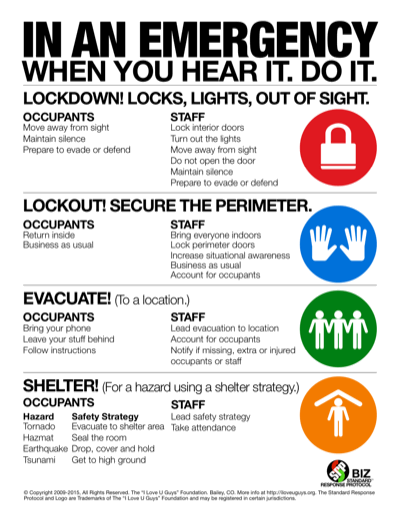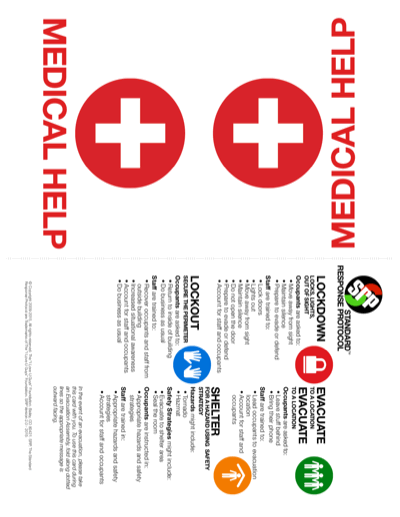A critical ingredient in personal safety is a standard response to any incident. Weather events, TM fire, accidents, intruders and other threats to personal safety are scenarios that institutions plan and train for.
Historically, institutions have taken this scenario-based approach to respond to hazards and threats. It's not uncommon to find a stapled sheaf of papers or even a tabbed binder in a desk that describes a variety of things that might happen and the specific response to each event.
This version of our flagship program, the Standard Response Protocol (SRP) focuses on staff training to address the issue of having occupants who may not be familiar with the SRP.
The Standard Response Protocol (SRP) is based not on individual scenarios but on the response to any given situation. Like the Incident Command System (ICS), SRP demands a specific vocabulary but also allows for great flexibility. The premise is simple - there are four specific actions that can be performed during an incident. When communicating these, the action is labeled with a "Term of Art" and is then followed by a "Directive." Execution of the action is performed by active participants and first responders.
The benefits of the SRP become quickly apparent. By standardizing the vocabulary, all stakeholders can understand the response and status of the event. This common language is being taught to millions of students in the US and Canada. As these students enter the workforce or are in non school environments, having the same language and expectations provides a more conditioned response. Additionally, this protocol enables rapid response determination when an unforeseen event occurs.
The protocol also allows for a more predictable series of actions as an event unfolds. An intruder event may start as a Lockdown, but as the intruder is isolated, first responders might transition parts of the building to an Evacuation.
Downloadable versions of all materials are made available at no cost.
Optionally, you can purchase printed materials.
 SRP BIZ Poster
SRP BIZ Poster
The office poster gives staff and occupants a quick reference of the SRP terms and actions.
Download the PDF
 SRP BIZ - Red Card/Green Card
SRP BIZ - Red Card/Green Card
We offer three different versions of the cards. Choose the one that fits your needs.
This 3.5 day Symposium examines lessons learned from traumatic events and reveals new, preemptive school safety measures growing in multiple realms. The Symposium is designed to provide a number of takeaways that districts, departments and agencies can implement immediately. This is not open to the public, and attendees will be asked to show an agency or organization I.D. upon check-in.
Law enforcement, school personnel, victim advocates, mental health professionals, emergency and risk management staff, school safety teams and all first responders.
Presenters include school administrators, law enforcement, criminal justice and school security administrators who have been involved in the response and recovery to school violence and other events.
Find Out MoreIt does not mean to be in a place where there is no noise, trouble, or hard work.
It means to be in the midst of those things and still be calm in your heart.